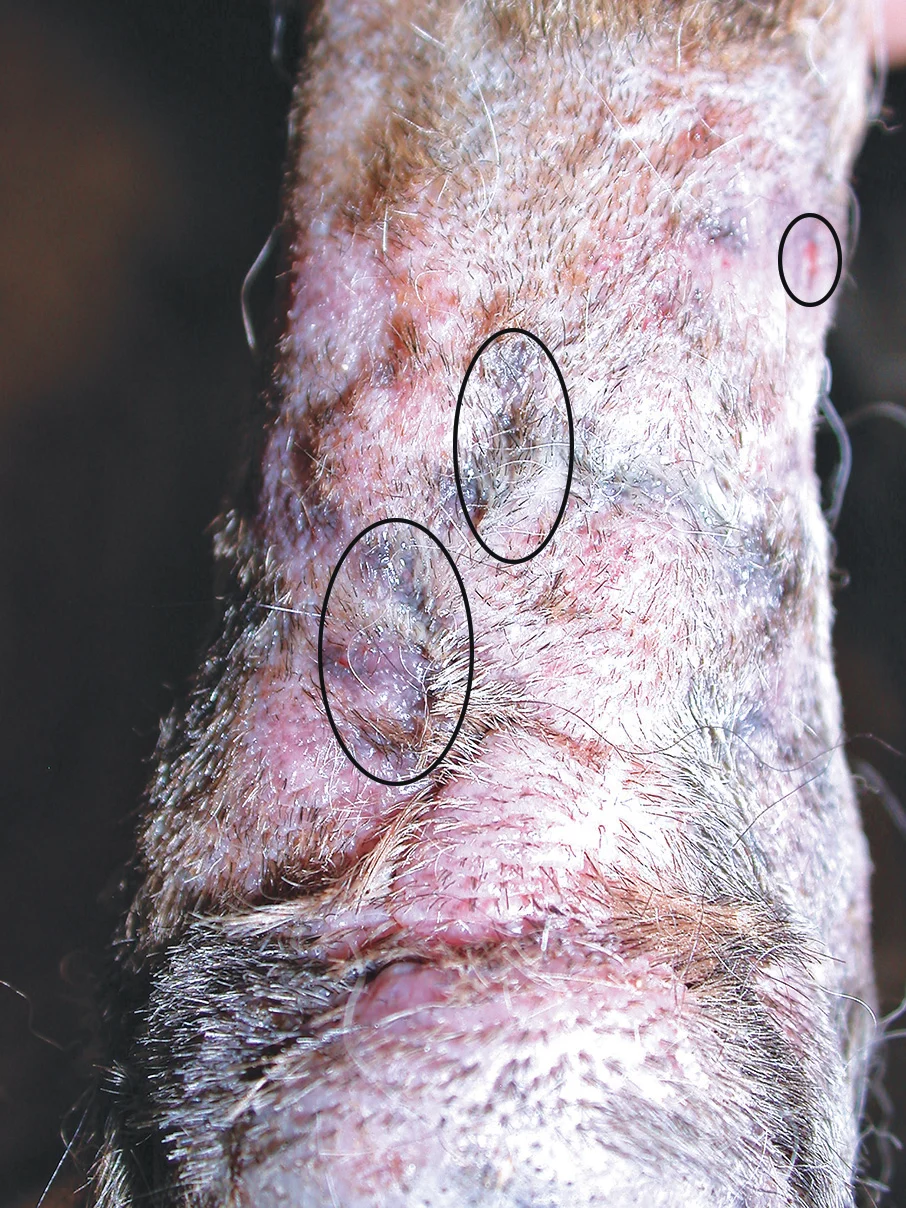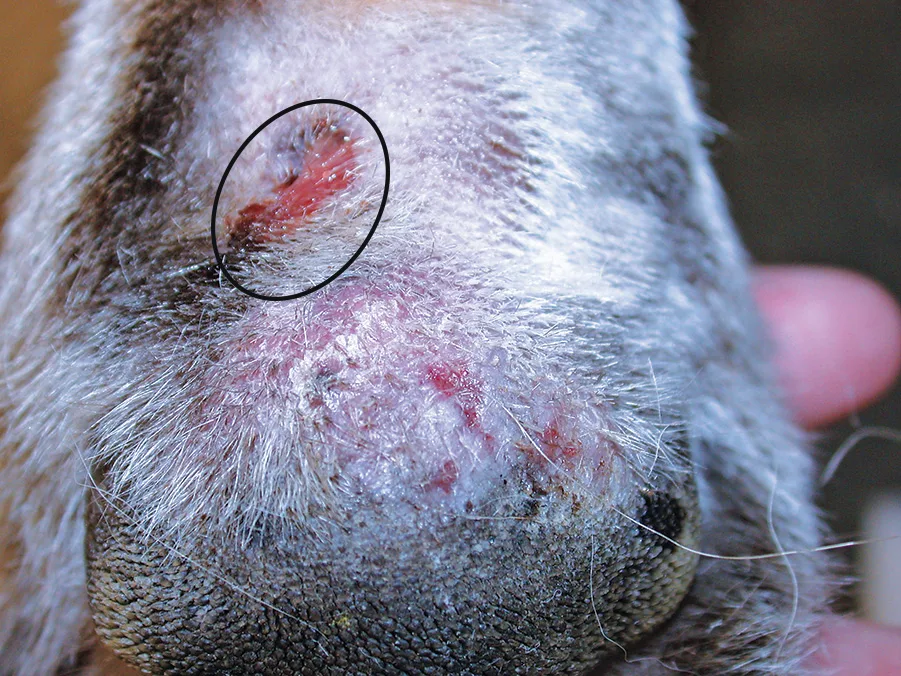Metatarsal Draining Tract in a German Shepherd Dog
Danielle R. Tulloss, DVM, DACVPM, Dermatology Clinic for Animals, US Army Reserves, Lacey, Washington
Danielle N. Wyatt, DVM, DACVD, Dermatology Clinic for Animals, Lacey, Washington
Kimberly Coyner*, DVM, DACVD, Formerly of Dermatology Clinic for Animals, Lacey, Washington

Clinical History & Signalment
Remi, a 4-year-old spayed German shepherd dog, was presented to a dermatology referral clinic for evaluation of a unilateral draining tract proximal to the right metatarsal pad of 4 months’ duration. The draining tract was not pruritic and only noted after blood-tinged spots were occasionally seen on the floor of the home. The discharge was reported to originate from the draining lesion on the right pelvic limb, and the owner did not believe the lesion had changed over time.
Remi lived primarily indoors with access to a fenced yard. She was housemates with another dog and a cat; both were unaffected. Remi was otherwise apparently healthy, and no lameness or discomfort of the area had been observed. Vaccinations and flea, tick, and heartworm preventives were current.
The referring clinician performed cytology of the right metatarsal exudate that revealed scattered extracellular cocci bacteria with pyogranulomatous inflammation, and cefpodoxime (5 mg/kg PO every 24 hours) was administered for 21 days with no improvement. Routine CBC and serum chemistry profile were unremarkable. Orthopedic examination was within normal limits; radiography was thus performed, and results were normal. Subsequent surgical exploration by the referring clinician revealed no foreign body inside the wound, but a subcutaneous sinus extending ≈1.5 cm proximally was found. Enrofloxacin (5 mg/kg PO every 24 hours) and carprofen (2.2 mg/kg PO every 12 hours) were administered for 14 days with no improvement. Bacterial cultures were not collected.
Remi was referred to the dermatology clinic for evaluation.
Physical Examination
On presentation at the dermatology referral clinic, Remi was bright, alert, and responsive. Vital signs were within normal limits. BCS was 4/9, pain score was 0/4, and muscle condition score was adequate.
Dermatologic examination revealed matted fur, indurated and inflamed skin, and several small draining tracts with serous discharge on the right ventral metatarsus extending ≈6 cm proximal to the metatarsal pad (Figure 1). The left metatarsal region was also mildly affected, and there was a focal area of fistulation, hypotrichosis, hyperemia, and edema of the skin proximal to the left metatarsal pad (Figure 2). Scattered areas of pinpoint erosions were also present.

Area on the right pelvic limb proximal to the metatarsal pad characterized by matted fur; indurated, erythematous, edematous skin; and multifocal chronic fistulae (circles) surrounded by serous discharge

Lesion on the left pelvic limb proximal to the metatarsal pad with a draining fistula (circle), erythema, hypotrichosis, and superficial erosions
Diagnosis
Cytologic examination of right and left limb lesions revealed pyogranulomatous inflammation characterized by neutrophils, macrophages that were often multinucleate with foamy cytoplasm, and smaller numbers of plasma cells and lymphocytes; no infectious organisms were seen. A deep skin scraping was negative for mites.
A full-thickness punch biopsy of affected tissue under local anesthetic was performed; results revealed a deep pyogranulomatous, nodular-to-diffuse dermatitis and panniculitis with fibrosis and fistulous tracts. The infiltrate contained neutrophils, macrophages, plasma cells, and lymphocytes. Periodic acid-Schiff, acid-fast, and Gram stains were negative for fungal and bacterial organisms, and tissue cultures for aerobic and anaerobic bacteria and fungi were negative. No demodectic mites or other parasites were identified on biopsy.
DIAGNOSIS:
BILATERAL METATARSAL FISTULAE
Treatment & Long-Term Management
Bilateral metatarsal fistulae were suspected, and treatment was initiated according to current recommendations, pending biopsy results.1 There was a 30-day washout period between administration of carprofen and prednisone. An anti-inflammatory dose of prednisone (1 mg/kg PO every 24 hours for 7 days) was administered due to the high index of suspicion for bilateral metatarsal fistulae.1 Rapid improvement of lesions resulted. Prednisone was reduced to 1 mg/kg every 48 hours beginning on day 8, but lesions worsened by day 14.
On day 14, topical tacrolimus 0.1% ointment was initiated every 12 hours for 14 days; marked reduction in edema occurred after topical tacrolimus was added to the management plan, and tacrolimus allowed for furthering tapering of prednisone. On day 28, prednisone was reduced to 1 mg/kg PO every 72 hours for 3 doses, then stopped. Topical tacrolimus was simultaneously reduced to once every 24 hours and administered for an additional 21 days.
Metatarsal fistulae were resolved at the 8-week recheck, and topical tacrolimus was tapered to every 48 hours for 30 days, then twice weekly for 30 days, and discontinued on day 118.
TREATMENT-AT-A-GLANCE
Sole therapy with 0.1% tacrolimus topical ointment every 12 hours may lead to remission after 3 to 6 weeks and can be tapered to once every 24 hours, followed by alternate-day therapy3,4; treatment can be discontinued in some patients.
Some dogs require oral immunomodulatory therapy. It is often recommended to start with prednisone (1 mg/kg PO every 24 hours, tapered to a maintenance regimen of, ideally, 0.25-0.5 mg/kg PO 1-2 times per week) or cyclosporine (5 mg/kg PO every 24 hours, tapered to the lowest frequency that maintains remission after 4-6 weeks of treatment).1,5-7 Lesions may relapse at less-frequent intervals of administration without additional topical therapy (eg, tacrolimus, oral steroid-sparing drugs).1,5-7
Vitamin E (200-300 IU every 12 hours) has been used to reduce the maintenance dosage of glucocorticoids.6
Systemic antibiotic treatment may improve lesions with secondary bacterial infection but does not lead to resolution.2
Bilateral metatarsal fistulae are suspected to be immune-mediated, and surgical excision of fistulae is not curative; lesions recur weeks to months later.2,3
Prognosis & Outcome
Lesions were resolved 8 weeks after treatment was started. Remi was still in complete remission 2 months later, and bilateral metatarsal fistulae had not recurred after 6 months.
Prognosis for metatarsal fistulae is excellent with appropriate medical management. Immunomodulatory or immunosuppressive therapy often leads to long-term remission but may be required chronically. Lesions typically persist when left untreated and do not respond to surgical removal alone. Spontaneous remission is possible but rare.2
TAKE-HOME MESSAGES
Metatarsal and metacarpal fistulae (focal metatarsal/metacarpal fistulation, sterile pedal panniculitis) are uncommon and usually seen in adult German shepherd dogs and their crossbreeds but have been reported sporadically in rottweilers, Weimaraners, and greyhounds.2,3,5,6 To the authors’ knowledge, metatarsal fistulae are not associated with other immune-mediated fistula syndromes (eg, perianal fistulae, which are commonly seen in German shepherd dogs).1
Both pelvic limbs are typically involved, and lesions are idiopathic, yet pathognomonic, in German shepherd dogs.1 Lesions are infrequently unilateral, and thoracic limbs are occasionally affected along the caudal metacarpal region just proximal to the metacarpal pads.1,2 In many patients, lesions are striking, and additional investigation is often not warranted; however, chronic metatarsal fistulae can appear ulcerated, edematous, and crusted. Because the condition is chronic, there are many differentials, including infectious, immune-mediated, neoplastic, and idiopathic causes.1 In this patient, infectious organisms were not identified on aerobic culture or histopathology, supporting the diagnosis of bilateral metatarsal fistulae. Although the presentation of bilateral metatarsal fistulae is often straightforward, this is not always the case for chronic conditions, and additional infectious and immune-mediated causes should be ruled out before immunomodulatory or immunosuppressive treatments are initiated.1
Differential diagnoses for unilateral lesions include foreign bodies, puncture wounds, and deep bacterial or fungal infections.1,2,5,7
Acute lesions appear as fluctuant swellings or edema along the central plantar surface of the metatarsus just proximal to the metatarsal pad, progressing to well-demarcated fistulae with serosanguinous discharge.5 Lesions do not usually seem to affect dogs, and pet owners typically only notice lesions when the patient licks the skin or bloody spots appear on the floor.1
Etiology and mechanism of this condition are unknown, but an immune-mediated process may be responsible.2,5 Strong breed predisposition implies heritability.1,7
Bilateral metatarsal fistulae are generally chronic and do not tend to spontaneously regress, but the disease is usually responsive to immunomodulatory and immunosuppressive medications. Some patients may stay in remission once treatment is completed; others may require lifelong management.5